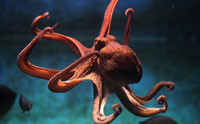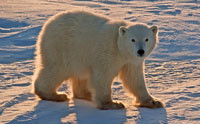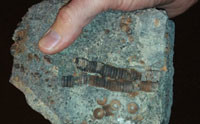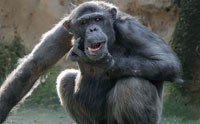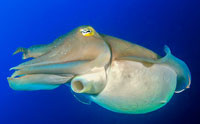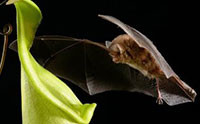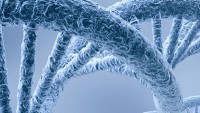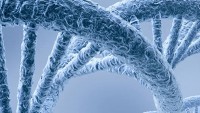The amazing octopus continues to astonish scientists. “Octopuses are highly intelligent creatures,” says Claire Little, a marine biologist at the Weymouth Sealife Center in southwest England. “They are classed as intelligent as the general home pet dog.” Scientists recently sequenced the octopus’ genome and found it’s nearly the size of the human genome. More… …read more Read more here: icr.org
By Dr. Nathaniel T. Jeanson Some biblical creationists have fallen into the evolutionists’ trap and tried to refute evolution by throwing out the concept of natural selection entirely. …read more Read more here: AIG Daily
By Dr. Gary Parker Why should a person’s arm have the same kind of bone pattern as the leg of a dog and the wing of a bat? There are two basic ideas. …read more Read more here: AIG Daily
By Dr. Elizabeth Mitchell Three of the genes that control our immune system’s first line of defense (and our allergies) bear a significant footprint from Neanderthals. …read more Read more here: AIG Daily
Researchers have uncovered scientific evidence that the human brain recognizes the existence of God. Scientists have discovered that the reality of God is hardwired into the human brain — even by those who are not taught directly taught about Him — according to new research divulged by National Geographic. Global Neuroscience Initiative Foundation Executive Director Shaheen E. Lakhan, who holds numerous doctorate degrees, including an M.D. from the Technion-Israel Institute of Technology, contends that something that has been revealed by the Bible for millennia is now recognized by modern science. Read More: Research: Brain recognizes reality of God
Namib desert beetles collect faint water droplets on their exquisitely designed outer surfaces so they can survive in their dry environments. And polar bears keep a tight grip on smooth ice using precisely designed footpads. Engineers have copied these exquisite designs to make useful tools. More… …read more Read more here: icr.org
By Dr. Gary Parker It’s what we do know and can explain about DNA and protein and the laws of chemistry which suggests that life itself is the result of special creation. …read more Read more here: AIG Daily
The Deep Down Under project explores “relict faunas,” living creatures with eerily similar counterparts among some of the world’s oldest fossils. Deep-sea researchers used a remotely operated vehicle (ROV) to look for life around Osprey Reef off Queensland’s coast. They found some surprises including animals known only from faraway places and long-gone times. More… …read more Read more here: icr.org
By Dr. Elizabeth Mitchell If a computer simulation can trace a path for the evolution of multicellular organisms from single-celled ones, does that mean they actually evolved that way? …read more Read more here: AIG Daily
“Here is another marvel of complexity in nature that we are supposed to believe just happened by chance … ridiculous.” Admin By By David Gutierrez, staff writer (NaturalNews) Scientists are beginning to uncover the mechanisms by which plants — which depend upon sunlight to provide them with energy — protect themselves from the damaging effects of the sun’s ultraviolet rays. Most recently, in a study published in the Journal of the American… …read more Read more here: Natural News
When the tarsier opened its mouth and no sound could be heard, people thought it was simply yawning or stretching. How wrong they were. …read more Read more here: creation.com
Whoever said the human brain is the most highly organized collection of matter in the universe was more correct than they could have known. New research modeled tiny structures within nerve cells and discovered a clever tactic brains use to increase computing power while maximizing energy efficiency. Its design could form the basis of a whole new and improved class of computer. More… …read more Read more here: icr.org
In complete contradiction to evolutionary predictions, the language systems in the genome continue to reveal nothing but unimaginable complexity. As a news story on a recent discovery explains, “The world of epigenetics…has just got bigger with the discovery by a team of scientists from the University of Cambridge of a new type of epigenetic modification.” More… …read more Read more here: icr.org
By Dr. Elizabeth Mitchell The National Geographic article treats every aspect of our world of vision as evidence for evolution: eye diversity and the fact that eyes share common designs. …read more Read more here: AIG Daily
The process of cell division is so complicated and selective that evolutionists can’t adequately explain its origin. …read more Read more here: creation.com
They seem cute when young. And cranky when they’re older … but bears are some of God’s most amazing creatures! …read more Read more here: creation.com
Increasingly, orphan genes defy evolution and support the Genesis account of creation. These genes are unique sets of coding sequences specific to particular creatures. This is a big problem for evolutionary ideas to explain. In a recent research report, scientists describe a new set of 1,307 orphan genes that are completely different between humans and chimpanzees. More… …read more Read more here: icr.org
Naturalistic objections to the design argument from autopoiesis fail by begging the question. …read more Read more here: creation.com
‘Autopoiesis’ (self-making) shows that all aspects of life lie beyond naturalistic explanations. …read more Read more here: creation.com
By Dr. Georgia Purdom The issues of cloning and stem cells raise many emotional and ethical concerns. How do we think biblically regarding these topics? …read more Read more here: AIG Daily
By Dr. Elizabeth Mitchell Scientists believe protein sequences from dinosaur blood vessel walls may help them map evolutionary relationships. …read more Read more here: AIG Daily
Many zoologists consider cuttlefish to be the most intelligent invertebrate species, which is quite a problem from an evolutionary perspective. Evolutionists view intelligence evolving through social interactions and long lifespans. But cuttlefish are cephalopods. They don’t have a complex social structure and live only about a year—the lifespan of a butterfly. How did cuttlefish become so bright? More… …read more Read more here: icr.org
Researchers at the University of Texas Southwestern Medical Center discovered a gene called NORAD that, unlike protein-coding genes, makes a long functional RNA that works directly in the cell’s nucleus. NORAD helps preserve the correct number of chromosomes in cells (e.g. 46 for humans). Conversely, the cellular chromosome number becomes unbalanced when the NORAD gene goes awry, a common trait in cancerous cells. Could the NORAD gene aid cancer research? More… …read more Read more here: icr.org
Incredible lens engineering in an ‘early’ creature. Trilobites, described by Stephen Jay Gould as ‘everyone’s favourite invertebrate fossil,’ are a class of marine arthropods which are often well preserved and of striking appearance.1,2 They are believed to be extinct. They are mostly between 10 and 50 mm long (3/8 to two inches) although a few species attained a length of 750 mm (2 1/2 feet). Trilobites are characterized by a ridged carapace, or shell, made of chitin, divided into three lobes which give the class its name. While most trilobites had eyes, a number had none. A common [More]
Every year scientists discover new and amazing animal designs, and 2015 was no exception. Each find brings a new reminder of the same message every generation needs to hear: “The heavens are Yours, the earth also is Yours; The world and all its fullness, You have founded them. The north and the south, You have created them.” More… …read more Read more here: icr.org
By Dr. Elizabeth Mitchell Some think acorn worms, virtually unchanged since the Cambrian explosion, represent an evolutionary link between invertebrates and humans. …read more Read more here: AIG Daily
By Frost Smith Creationist scientists Drs. Tomkins and Bergman came up with an overall DNA similarity between humans and chimps of around 81%—quite a difference! …read more Read more here: AIG Daily





















